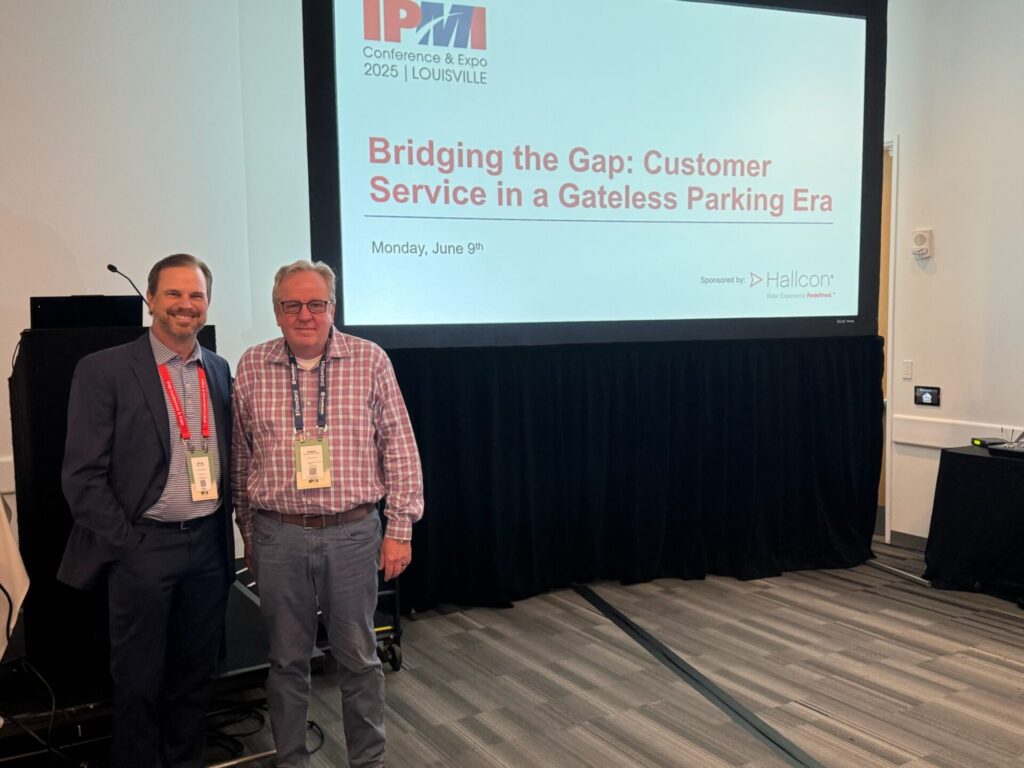
When it comes to parking, the endgame is simple: get people in quickly, get them out quickly and make sure they know they still need to pay for the privilege.
But when you remove the gates, literally, the playbook changes.
In our recent IPMI session, Adam Jones and Brian Wolff shared insights from managing gateless parking in two very different cities: Tempe, Arizona and Detroit, Michigan. The journey has been anything but “set it and forget it,” and the lessons learned along the way are shaping the future of gateless technology in real-world operations.
Gateless Isn’t One-Size-Fits-All
Adam started with the basics: “gateless” doesn’t always mean the same thing.
- Full Gateless – 100% app-based payment, no gates, free-flow in and out. Great for monthly parkers but can pose challenges for payment compliance.
- Hybrid Gateless – Combines elements of gateless with some physical controls (like gates for directional flow or multiple payment options).
- Hard Card / Fully Gated – Traditional model where gates open only for registered or validated parkers.
Over time, more operators have shifted from fully gateless to hybrid, largely to address compliance issues. As Brian pointed out, this shift isn’t just about technology – it’s about unlearning decades of driver conditioning.
For many people, an open gate still signals “free parking,” no matter how many signs you put up.
Case Study: Tempe, AZ
Tempe’s downtown is a unique ecosystem – bustling with office workers, residents, ASU students, and a late-night bar crowd. Broken gates during peak times (like 2 a.m. bar close) made traditional setups a nightmare.
The Solution: A hybrid gateless approach – no gates, but with payment kiosks and boots-on-the-ground enforcement.
The Benefits:
- Faster exits and fewer 2 a.m. traffic jams
- Flexibility to enforce compliance through both technology and in-person monitoring.
The Trade-Offs:
- Customer confusion in the early days, especially for occasional visitors
- Privacy pushback from early text-based enforcement methods
- Ongoing need to refine signage and communication
Brian emphasized that success wasn’t about going all-in on technology. It was about pairing tech with human presence and real-time adjustments, plus having the humility to stop doing things that weren’t working – like overly-aggressive enforcement.
Case Study: Detroit, MI
Detroit’s situation was shaped by COVID-19. With downtown demand plummeting, Bedrock removed gates entirely, adopted Metropolis’ gateless system and reduced staffing.
The Benefits:
- Frictionless experience for 16,000+ FOC otherwise known as family of company team members such as Rocket.
- Easy onboarding for monthly parkers through app integration
- Revenue up significantly compared to pre-gateless; now hitting over 90% compliance after 120 days
The Adjustments:
- Reworked signage multiple times to ensure clarity at entry
- Adopted a more customer-friendly collections process (waiving fees if paid within two weeks)
- Added integrations with platforms like ParkWhiz and SpotHero to expand payment options
The Challenges:
- Managing occupancy without gates requires real-time monitoring and boots on the ground
- Balancing customer service with enforcement – some facilities may still benefit from returning to a gated model
Signage, Staffing & the Human Element
In both cities, clear and abundant signage proved critical. If customers don’t get the message at entry, compliance will suffer.
And while “gateless” might sound like an excuse to cut staff, reality says otherwise. Adam’s teams rely on fewer, but more skilled, cross-trained employees – people who can handle customer service, enforcement and tech troubleshooting all in one.
Brian reminded that it’s not just “less labor,” it’s different labor. You still need boots on the ground – just deployed in smarter, more impactful ways.
Looking Ahead: Tech + Human Service
The next evolution? Dynamic, digital signage with voice prompts, AI-enabled kiosks, and real-time language translation.
But Adam and Brian agree: AI won’t replace humans; it will enhance them.
The Z Garage in Detroit will serve as a testbed for blending AI-powered tools with live customer service. The goal: keep the experience seamless, the communication clear and the customer happy – whether they’re tech-savvy or tech-averse.
Key Takeaways for Parking Operations
- Match the model to the market: a system that works in one city may flop in another
- Signage is your first line of defense: if they don’t understand how to pay, compliance will suffer
- Boots on the ground still matter: tech can’t replace human presence for support and enforcement
- Adapt as you go: gateless is still in its infancy; be ready to tweak, hybridize or pivot entirely
- Balance customer service with enforcement: education first, enforcement second
Gateless parking is here to stay, but it’s not a magic bullet. The real magic comes from blending innovative tech with human problem-solving – and from leaders who are willing to learn, adjust and keep the focus where it belongs: on the customer experience.

Brian Wolff
CEO
Brian brings 35 years of business experience in the parking, technology and life sciences industries to his position as President & CEO of Parker Technology. Under his leadership, Parker has achieved 8 years of revenue and customer growth, all while evolving a cloud-based service and software platform to be infinitely configurable to meet the needs of all types of parking operations.
